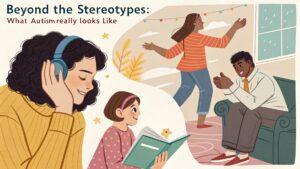Imagine walking into a supermarket, and the fluorescent lights feel like piercing spotlights. The hum of the refrigerators is a deafening roar, and the kaleidoscope of colorful packaging is a dizzying assault on your eyes. For many, this is a routine errand. But for someone with sensory sensitivities, particularly an autistic individual, it can be an overwhelming, and at times, unbearable experience. This isn’t about being ‘picky’ or ‘overly dramatic’; it’s about a fundamental difference in how the brain processes the world. This post aims to move beyond generic definitions, offering a deeper understanding and explaining sensory processing differences in autism through unique insights and personal experiences.
For decades, the conversation around autism has often centered on social communication challenges. While crucial, this focus can sometimes overshadow an equally significant aspect of the autistic experience: the daily navigation of a world that can feel like a sensory minefield.
More Than Just Five Senses: A Deeper Dive
We’re all familiar with the five senses: sight, sound, smell, taste, and touch. However, our bodies are constantly processing information from three additional, lesser-known senses that are critical for our interaction with the world:
- Vestibular: Our sense of balance and spatial orientation, governed by our inner ear. It tells us if we’re moving, how fast, and in what direction.
- Proprioception: Our body’s awareness of itself. It’s how we know where our limbs are without looking at them. This sense is what allows us to clap our hands with our eyes closed.
- Interoception: Our internal body sense. It alerts us to internal states like hunger, thirst, needing to use the restroom, or feeling our heart race with anxiety.

For neurotypical individuals, the brain seamlessly integrates the information from all eight senses, filtering out what’s irrelevant and allowing us to focus on the task at hand. For an autistic person, this filtering system can be wired differently, leading to a world that is often too loud, too bright, and simply too much.
Hypersensitivity vs. Hyposensitivity: Two Sides of the Same Coin
Imagine your brain has a sensory volume knob. For most people, it’s set just right—loud enough to notice what matters, quiet enough to tune out the rest. But for many autistic individuals, that volume knob can shift wildly. Some days, it’s turned way up. Other days, it’s barely audible. And sometimes, different senses are on totally different settings at the same time.
This is the world of sensory processing differences—specifically, hypersensitivity (over-responsiveness) and hyposensitivity (under-responsiveness). These aren’t opposites in a rigid sense, but two experiences that often coexist and change depending on the environment and a person’s state of well-being.
🔊 When the World Feels Too Loud: Hypersensitivity
Hypersensitivity happens when the brain is flooded with too much sensory input. It’s like trying to have a quiet conversation while standing next to a blaring speaker. Everything feels louder, brighter, rougher, or more intense than it should.
Common signs of hypersensitivity include:
- Sound sensitivity: A buzzing light, ticking clock, or distant siren might feel overwhelmingly loud or even painful. Sudden noises can cause panic or sensory overload.
- Touch sensitivity: Clothing tags may feel unbearable. Light touches might feel more like jabs, and even the texture of certain fabrics can cause distress.
- Visual overload: Fluorescent lights may trigger headaches or visual distortion. Busy environments can feel chaotic and hard to navigate.
- Smell sensitivity: Everyday odors like cleaning products or perfumes can feel overpowering, even nauseating.
For someone experiencing hypersensitivity, ordinary environments—like a grocery store or classroom—can feel intense and exhausting.
🔈 When the World Feels Too Quiet: Hyposensitivity
Hyposensitivity is the opposite: the brain isn’t registering enough input, so it craves more. It’s like the sensory volume is too low, and the brain is straining to turn it up. This can lead to behaviors that might seem unusual—but are really about getting needed input.
Common signs of hyposensitivity include:
- Seeking movement: Spinning, jumping, pacing, or swinging can help stimulate the vestibular system. It’s not just play—it helps the person feel “in their body.”
- Touching everything: People may crave deep pressure, crash into things, hug tightly, or seek out tactile feedback from textures and objects.
- Not noticing pain or temperature: They might not feel a scraped knee or may tolerate extreme heat or cold with little reaction.
- Strong taste preferences: Foods with intense flavors—spicy, sour, crunchy—can help register taste more effectively.
These behaviors aren’t about misbehavior or odd preferences—they’re strategies to self-regulate and feel balanced in the world.
🧩 A Blended Sensory Profile
It’s important to know that most autistic people don’t fall neatly into one category. Someone might be hypersensitive to sound but hyposensitive to touch. Or their sensory needs might shift depending on stress levels, fatigue, or setting.
Understanding these sensory differences can lead to greater empathy and more supportive environments—at home, in schools, and in the community. It’s not about fixing or changing the person; it’s about adjusting the surroundings so they can thrive.

These differences aren’t just preferences; they are neurological. Research suggests that the brains of autistic individuals may have differences in connectivity and in a process called “sensory gating,” which is the brain’s ability to filter out redundant sensory information. When this filter is less effective, it can lead to sensory overload.
A Walk in Their Shoes: Personal Perspectives on Sensory Overload
To truly grasp the impact of these differences, listening to the lived experiences of autistic individuals is paramount. Here’s a glimpse into what that can feel like:
“Going to a concert is a battle,” shares a young autistic adult. “It’s not just the music. It’s the sticky floor, the press of bodies, the flashing lights that seem to sear my retinas, and the cacophony of a thousand different conversations hitting me at once. By the end, I’m not just tired; I’m completely depleted, my nervous system shot.”

Another individual describes their experience with interception: “I often don’t realize I’m hungry until I’m lightheaded and irritable. It’s not that I don’t feel hunger; the signal just doesn’t seem to get through until it’s an emergency. The same goes for feeling thirsty or tired. I have to consciously check in with my body throughout the day.”
These experiences highlight how sensory sensitivities can impact every facet of life, from social outings and mealtimes to personal well-being and emotional regulation. A meltdown in a crowded mall might not be a behavioral issue, but a physiological response to an environment that has become intolerably overwhelming.
Navigating the World: Practical Strategies and Accommodations
Understanding these sensory differences is the first step. The next is creating a more accommodating and inclusive world. Here are some strategies that can make a significant difference:
For Hypersensitivities:
- Create Sensory-Friendly Environments: Dimmer lighting, reduced noise levels, and fragrance-free spaces can transform a stressful environment into a welcoming one.
- Sensory Toolkits: Noise-canceling headphones, sunglasses, fidget toys, and weighted lap pads can be invaluable tools for managing sensory input on the go.
- Predictability and Routine: Knowing what to expect can reduce the anxiety associated with new or overwhelming sensory experiences. Visual schedules and social stories can be particularly helpful.
For Hyposensitivities:
- Incorporate Sensory Input: Provide opportunities for movement and deep pressure, such as using a yoga ball as a chair, taking regular breaks for jumping jacks, or offering a weighted blanket.
- Engage the Senses: Offer foods with strong flavors and varied textures, use essential oil diffusers with pleasant scents, and provide a variety of tactile objects to explore.

Fostering a More Inclusive Future
Explaining sensory processing differences in autism is not just about raising awareness; it’s about fostering empathy and driving meaningful change. It’s about recognizing that a person’s “unusual” behavior might be a perfectly logical response to their sensory reality. By making small adjustments, we can create a world that is more comfortable and accessible for everyone.
The next time you see someone wearing headphones in a seemingly quiet place or avoiding eye contact in a brightly lit room, consider the unseen sensory world they might be navigating. A little understanding can go a long way in making the world a less overwhelming place for our autistic friends, family, and colleagues.

What are your experiences with sensory sensitivities, either personally or with someone you know? Share your thoughts and strategies in the comments below. Let’s learn from each other and build a more sensory-inclusive community.
Explore our other articles on autism and neurodiversity to continue learning.
Sign up for our newsletter to receive more insightful content directly in your inbox.




